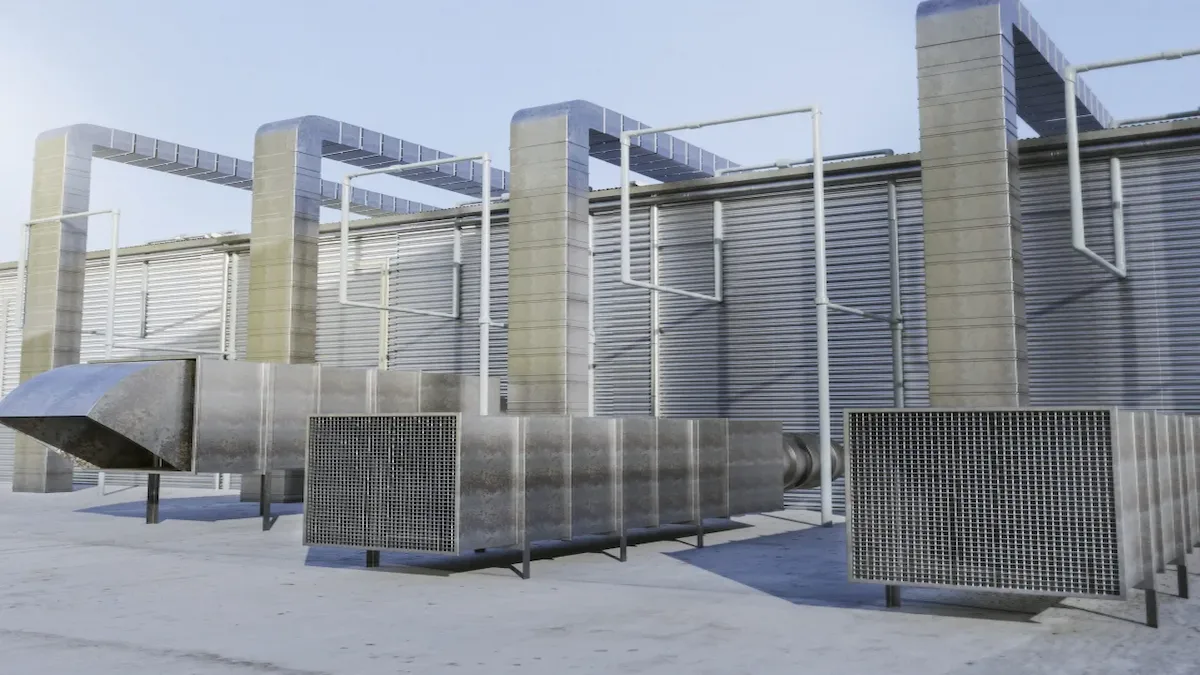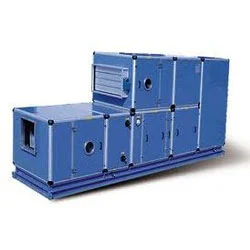Mastering Industrial Air Conditioning: Comprehensive Guide to Systems, Components, and Efficiency
Cool your industrial space efficiently! Learn all about different AC plant systems, how they work, and how to keep them running smoothly.
Introduction
Industrial air conditioning system are essential for maintaining optimal conditions in various industries. They help control temperatures in large spaces. Also, it keeps machinery running smoothly, preserves products, and ensures worker comfort. This guide covers everything you need to know about these systems. You will learn about their components, different types, how to design and install them, and how to maintain them. We will also discuss energy efficiency and future trends. Whether you work in an industry or want to learn more, this guide provides clear and practical information on air conditioning plants.
Key Takeaways
- Air Conditioning plants are essential across industries. It maintains optimal conditions and operational efficiency.
- Air conditioning plant understands centralized, decentralized, and hybrid systems. They help tailor solutions to specific industrial needs.
- Proper design, sizing, and proactive maintenance ensure reliability and cost-effectiveness.
- Embracing energy-efficient technologies and sustainable practices aligns with environmental goals and regulatory requirements.
What are Industrial Air Conditioning Systems?
An industrial air conditioning system is designed to control the temperature, humidity, and air quality in large industrial spaces. Industrial systems are built to handle larger loads. They operate under more demanding conditions. Unlike residential systems, they are designed for heavier use. They are used in manufacturing plants, data centres, laboratories, and other industrial facilities.
Differences Between Industrial and Residential Systems
Industrial systems are more robust and capable of managing large-scale environments. They are designed for continuous operation and can handle higher cooling loads. Residential systems, on the other hand, are smaller and meant for individual homes or small spaces.
| Aspect | Industrial Systems | Residential Systems |
| Capacity | Built for larger spaces and heavier loads. | Designed for smaller areas and lighter loads. |
| Operation | Often run continuously under demanding conditions. | Typically run intermittently in moderate conditions. |
| Complexity | More complex with sophisticated components and controls. | Simpler with basic components and controls. |
| Environment | Focus on durability and performance in harsh environments. | Emphasis on comfort and quiet operation. |
| Maintenance | Requires regular professional maintenance and servicing. | Less frequent maintenance and easier DIY upkeep. |
| Cost | Higher initial investment and operational costs. | Lower initial and operational costs. |
| Applications | Used in large industrial settings like factories and data centers. | Installed in homes and small businesses. |
Common Applications in Various Industries
Air conditioning plant maintains optimal conditions in various industries. They are essential in manufacturing plants to keep machinery cool. They also prevent servers from overheating in data centres and maintain precise laboratory conditions. Below are the typical applications of industrial air conditioning systems in various industries:
- Manufacturing Plants: Maintain stable temperatures for machinery.
- Data Centers: Prevent server overheating.
- Pharmaceuticals: Ensure precise climate control for production.
- Food Processing: Keep environments suitable for food safety.
- Automotive: Control paint booth temperatures and air quality.
- Chemical Plants: Stabilize temperature-sensitive processes.
- Textiles: Regulate humidity for fabric quality.
- Healthcare: Maintain sterile, comfortable environments.
- Electronics Manufacturing: Prevent damage from heat and humidity.
- Warehouses: Preserve perishable goods and improve worker comfort.
Basics of Air Conditioning
- History of Air Conditioning
Air conditioning has a rich history with early innovations dating back to ancient civilizations. Modern air conditioning began to take shape in the early 20th century with key milestones. It started with the invention of the first electric air conditioner by Willis Carrier in 1902. Since then, the technology has evolved significantly. It has lead to the sophisticated industrial systems we have today.
- Principles of Air Conditioning
The principles of air conditioning revolves around the refrigeration cycle. It includes four main processes: evaporation, compression, condensation, and expansion. These processes involve key concepts such as temperature, pressure, and heat transfer. These are fundamental in understanding how air conditioning systems work.
Components of an Industrial Air Conditioning System
- Primary Components
Compressors
Compressors are the heart of the air conditioning plants. They pump refrigerant through the system in various types. It includes reciprocating, screw, and centrifugal compressors. Each type has its unique functions and applications.
Condensers
Condensers release heat absorbed by the refrigerant. They come in different designs, such as air-cooled and water-cooled condensers, each with its working principles.
Evaporators
Evaporators absorb heat from the air or process fluid. They come in various designs, including shell-and-tube and plate-and-frame evaporators. It is tailored to different applications.
Expansion Valves
Expansion valves regulate the flow of refrigerant into the evaporator. They play a critical role in refrigeration and are available in thermostatic and electronic types.
- Auxiliary Components
Air Handling Units
Air handling units (AHUs) distribute conditioned air throughout the facility. They include filters, blowers, and heat exchangers.
Chillers and Cooling Towers
Chillers remove heat from a liquid coolant circulated through the system. Cooling towers help reject the heat absorbed by the chiller into the atmosphere.
Control Systems and Sensors
Control systems and sensors monitor and regulate the operation of the air conditioning system. They ensure optimal performance and energy efficiency.
Types of Industrial Air Conditioning Systems
Industrial facilities have unique cooling needs. Explore the different types of industrial air conditioning systems designed for maximum efficiency and temperature control.
- Centralized Systems
Centralized systems cool large areas or entire buildings from one central location. They offer advantages such as higher efficiency and easier maintenance. Typical applications include large office buildings and manufacturing plants.
- Decentralized Systems
Decentralized systems serve specific zones or areas within a facility. They are flexible and can be customized for different needs. These systems are used in smaller facilities or areas that need different conditions.
- Hybrid Systems
Hybrid systems combine features of both centralized and decentralized systems. They offer the flexibility of decentralized systems with the efficiency of centralized systems. Examples include systems that use both central chillers and local air handlers.
Design and Installation Considerations
- Load Calculation
Accurate load calculation is crucial for designing an efficient air conditioning system. Factors affecting load include heat sources, insulation, and occupancy. Methods such as Manual J and software tools help in precise load calculation.
- System Sizing and Selection
Matching the system capacity to the calculated load is essential. Consider future expansion to avoid undersizing or oversizing the system.
- Installation Best Practices
Proper site preparation and layout planning are critical to a successful installation. Following steps systematically and addressing common challenges ensures the system runs efficiently and reliably.
Operation and Maintenance
- Operational Best Practices
Proper start-up and shutdown procedures are essential for the system’s longevity. Monitoring system performance regularly helps identify issues early.
- Routine Maintenance
Regular inspections and servicing are necessary to keep the system in optimal condition. Common maintenance tasks include replacing filters and cleaning coils.
- Troubleshooting Common Issues
It is crucial to diagnose and fix common problems, such as refrigerant leaks and airflow issues. Preventative measures, such as regular inspections, help avoid breakdowns.
Energy Efficiency and Sustainability
- Energy-Saving Technologies
Technologies such as variable speed drives and advanced control systems improve energy efficiency. These technologies optimize the operation of compressors, fans, and pumps.
- Sustainable Practices
Using eco-friendly refrigerants and implementing energy recovery systems are essential for sustainability. These practices reduce the environmental impact of industrial air conditioning systems.
- Regulatory Compliance
Understanding relevant standards and regulations is essential for compliance. Following these standards ensures the system operates safely and efficiently.
Future Trends in Industrial Air Conditioning
- Technological Innovations
The future of industrial air conditioning includes smart systems and IoT integration. Advances in refrigerant technology also promise greater efficiency and lower environmental impact.
- Market Trends
There is a growing demand for energy-efficient systems. Industries strive to reduce costs and environmental impact. Emerging markets and new applications continue to drive innovation in the field.
Conclusion
This guide has covered the basics of industrial air conditioning system, their components, types, design considerations, operation and maintenance practices, energy efficiency, and future trends. Keeping up with advancements in industrial air conditioning is crucial. It helps maintain efficiency and sustainable systems. Adopting best practices and innovative solutions can lead to significant benefits.
Refcon Chillers is a leading provider of industrial air conditioning solutions. They specialize in designing and manufacturing high-performance chillers for various industries. This includes manufacturing, pharmaceuticals, data centres, and food processing. We are known for their reliability, energy efficiency, and advanced technology. Our products help maintain optimal temperatures and ensure smooth operations in industrial environments. With a commitment to innovation and customer satisfaction, Refcon offers customized solutions to meet specific cooling needs. Our expert team provides comprehensive support, from installation to maintenance. Thus ensuring systems run efficiently and effectively. Refcon Chillers stands out for quality and performance in industrial air conditioning.
Frequently Asked Questions (FAQ)
What is an industrial air conditioning system?
An industrial AC system controls temperature, humidity, and air quality in large industrial spaces.
How does an industrial air conditioning system differ from a residential system?
Industrial systems handle larger loads and operate continuously under demanding conditions, unlike residential systems.
What are the main components of an industrial air conditioning system?
The main components include compressors, condensers, evaporators, expansion valves, auxiliary components like air handling units, and chillers.
How does the refrigeration cycle work in an industrial air conditioning system?
The refrigeration cycle involves four processes: evaporation, compression, condensation, and expansion, which work together to transfer heat.
What are common issues with industrial air conditioning systems and how can they be resolved?
Common issues like refrigerant leaks and airflow problems are resolved with regular maintenance and troubleshooting.
How can I prevent my industrial air conditioning system from breaking down?
Regular inspections, maintenance, and following operational best practices can prevent breakdowns.
What technologies are available to improve the energy efficiency of industrial air conditioning systems?
Technologies such as variable speed drives and advanced control systems improve energy efficiency.
How can industrial air conditioning systems be made more sustainable?
Regular checkups can prevent air conditioning problems like leaks and weak airflow.
What are the latest trends in industrial air conditioning technology?
Trends include smart systems, IoT integration, and advances in refrigerant technology.
How is the industrial air conditioning market evolving?
Businesses increasingly want eco-friendly air conditioning. These systems are finding new uses in more places.




